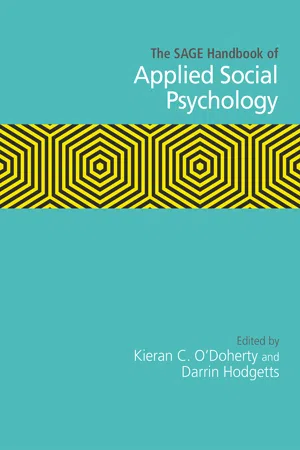
The SAGE Handbook of Applied Social Psychology
- 672 pages
- English
- ePUB (mobile friendly)
- Available on iOS & Android
The SAGE Handbook of Applied Social Psychology
About this book
In the present epoch of global change, movement, interconnection and the intensification of social issues within and across many societies, applied social psychology is more relevant than ever. The SAGE Handbook of Applied Social Psychology offers an overview of the field and the disparate and evolving approaches. Through an international team of contributors, the handbook brings prominent research literature together and organises it around ten key areas:
Part 01: Culture, race, indigeneity
Part 02: Gender & Sexuality
Part 03: Politics
Part 04: Health and mental health
Part 05: Work
Part 06: Ageing
Part 07: Communication
Part 08: Education
Part 09: Environment
Part 10: Criminal Justice, Law, & Crime
This handbook is a uniting and invigorating resource for the field of Applied Social Psychology.
Frequently asked questions
- Essential is ideal for learners and professionals who enjoy exploring a wide range of subjects. Access the Essential Library with 800,000+ trusted titles and best-sellers across business, personal growth, and the humanities. Includes unlimited reading time and Standard Read Aloud voice.
- Complete: Perfect for advanced learners and researchers needing full, unrestricted access. Unlock 1.4M+ books across hundreds of subjects, including academic and specialized titles. The Complete Plan also includes advanced features like Premium Read Aloud and Research Assistant.
Please note we cannot support devices running on iOS 13 and Android 7 or earlier. Learn more about using the app.
Information
Part I Culture and Indigeneity
1 Acculturation and its Application: A Conceptual Review and Analysis
Acculturation: A Conceptual Review and Analysis
Definition of Acculturation
Acculturation Strategies
Berry's acculturation strategies
Table of contents
- Cover
- Half Title
- Reviewers
- Title Page
- Copyright Page
- Contents
- List of Figures, Tables and Boxes
- Notes on the Editors and Contributors
- Introduction: Applied Social Psychology – An Evolving Tradition
- Part I Culture and Indigeneity
- 1 Acculturation and its Application: A Conceptual Review and Analysis
- 2 Heritage and (In)Equality: Social Psychology Applied to Race
- 3 Decolonising Applied Social Psychology: Culture, Indigeneity and Coloniality
- Part II Gender and Sexuality
- 4 Interventions to Reduce Violence against Women: The Contribution of Applied Social Psychology
- 5 Trans* and Gender Diverse Youth: Applied and Critical Social Psychology Working in the Margins
- 6 The Social Psychology of Gender and Sexuality: Theory, Application, Transformation
- Part III Politics
- 7 Towards an Applied Social Psychology of Democratic Citizenship
- 8 Critical Social Psychology of Politics
- 9 Macropsychology: Challenging and Changing Social Structures and Systems to Promote Social Inclusion
- Part IV Health and Mental Health
- 10 Social Cognitive Approaches to Health Issues
- 11 Critical Health Psychology: Applications for Social Action
- 12 Community Based Mental Health in Cultural Contexts: From Deinstitutionalisation to Engaged and Authentic Community Based Care
- Part V Work
- 13 Social Cognition in the Workplace: The Future of Research on the Meaning of Work
- 14 Applied Social Psychologies, the Neoliberal Labour-Market Subject and Critique
- 15 Standing Up for Sustainable Livelihoods: From Poverty to Prosperity
- Part VI Ageing
- 16 Ageing in Context: Ageism in Action
- 17 Social Policy and Social Identities for Older People
- 18 Successful Ageing and Community
- Part VII Communication
- 19 Social Cognition and Communication: From Attitudes and Persuasion to Cross-Cultural Psychology, Social Representations, Discourse, and the Technologies of Digital Influence
- 20 Discursive Psychology as Applied Science
- 21 Public Deliberation and Social Psychology: Integrating Theories of Participation with Social Psychological Research and Practice
- Part VIII Education
- 22 Applying Social Psychology to Education
- 23 Critical Layering in Participatory Inquiry and Action: Praxis and Pedagogy in Seeking Educational Change
- Part IX Environment
- 24 Using Social Psychology to Protect the Environment
- 25 The Psychogeographical Turn in Applied Social Psychology
- 26 Community and Participatory Approaches to the Environment
- Part X Criminal Justice, Law and Crime
- 27 Social Psychology and Law
- 28 Critical Social Psychology and Victims of Crime: Gendering Violence, Risk and Dangerousness in the Society of Captives
- Index